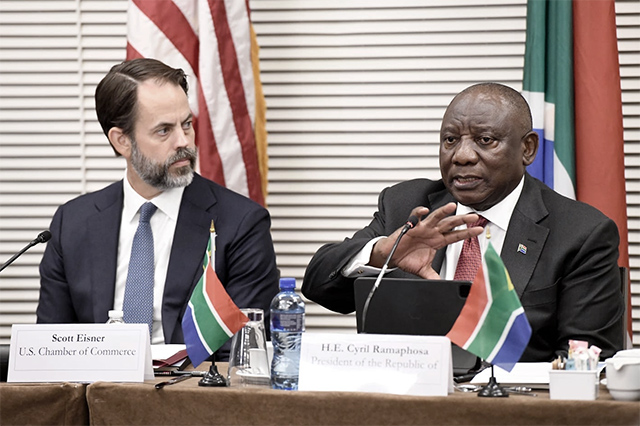Trade Imperatives for American manufacturers
U.S. industrial production has risen by two-thirds in the past 30 years. Manufacturing has bounced back from the pandemic recession and today employs 12.6 million Americans, with average earnings topping $30 per hour.
American manufacturers are on a roll. In sharp contrast to the “we don’t make anything here” refrain commonly heard in Washington, U.S. industrial production has risen by two-thirds in the past 30 years in inflation-adjusted terms. Manufacturing has bounced back from the pandemic recession and today employs 12.6 million Americans, with average earnings topping $30 per hour.
Trade is essential to the success of U.S. manufacturers. American exports of manufactured goods surpassed $1.13 trillion in 2021, a sum representing nearly half the sector’s total output. In other words, nearly half of everything made in American factories is destined for consumers overseas.
But there’s more to do to ensure that American manufacturers can secure the benefits of international trade and sharpen their global competitiveness.
How Can U.S. Manufacturers Win Better Access to Markets Abroad?
The answer to this question is simple: America’s trade agreements are designed to tear down the tariffs and other trade barriers that block U.S. exports, and they’ve delivered tremendous benefits for U.S. manufacturers and the workers they employ.
The U.S. has trade agreements with 20 countries representing just 7% of the world’s population, but these countries purchase nearly half of all U.S. exports. This shows a good trade agreement can turn even small markets into big opportunities.
However, while other economies race to ink new deals, the U.S. has not entered an agreement with a new trade partner in a decade. The Biden administration has yet to embrace a market-opening trade agenda — not even uncontroversial initiatives it inherited such as trade negotiations with the UK, our closest ally, or Kenya, a promising market in East Africa.
Meanwhile, the EU has 46 trade agreements with 78 countries, and a massive trade pact called the Regional Comprehensive Economic Partnership covering all of East Asia entered into force on January 1. These agreements mean better access to some of the world’s fastest growing markets — but not for American manufacturers.
The U.S. needs to get back in the game on trade agreements. America’s ability to deliver on a “make it here, sell it everywhere” agenda for U.S. manufacturers depends on it.
What Can Congress Do for U.S. Manufacturers?
Plenty. To start with the low-hanging fruit, the Chamber has urged Congress to pass the long-delayed Miscellaneous Tariff Bill (MTB), which the Senate approved as part of a broader trade package nearly a year ago on a 91-4 vote. With a three-decade track record of success, MTBs temporarily eliminate tariffs on select goods. The U.S. International Trade Commission leads a rigorous vetting process established by Congress to confirm that products proposed for tariff relief are not made in the U.S. or are unavailable in sufficient quantities to meet U.S. manufacturers’ needs.
MTBs enhance the competitiveness of American companies. Indeed, raising costs for U.S. manufacturers through the application of duties to inputs that are not available from domestic sources only hurts American workers and businesses.
Holding up the measure’s approval are some in the House who say finished goods should be disallowed from future MTBs. However, there’s no way MTBs can flood the U.S. market with duty-free imports of finished goods: There’s already a strict limit (no tariff relief petition can be included in the MTB package that implies a revenue loss in excess of $500,000 annually). The door should remain open to including finished goods in future MTBs.
How Do Tariffs Affect U.S. Manufacturers?
As noted, nearly half of U.S. manufacturing output is exported for sale to customers abroad, but it’s also true that roughly half of all U.S. imports are raw materials, parts, and components used by U.S. manufacturers. These inputs are generally unavailable from domestic sources at competitive prices or in the quantities needed.
Tariffs are a burden to U.S. families as well. The Congressional Budget Office has estimated that U.S. tariffs imposed in 2018-2019 — the overwhelming majority of which are Section 301 tariffs on goods imported from China — cost the average American household more than $1,200 in 2020 alone. Multiple studies show that nearly the entire burden of these duties has fallen on American families and companies.
For U.S. manufacturers, these tariffs have raised prices for a host of industrial inputs while contributing to the recent surge in inflation. Slapping tariffs on raw materials and industrial inputs undermines the growth of the innovative, value-added manufacturing industries that are the future of U.S. manufacturing. In short, these tariffs tend to favor a handful of businesses at the expense of a much wider swath of manufacturers employing many more American workers.
What’s the Future of the Section 301 Tariffs?
The administration is weighing its options, though a recent court ruling is raising pressure for officials to adjust the Section 301 tariffs imposed on imports from China. Meanwhile, the Chamber and many in Congress are advocating for legislation to establish a Section 301 tariff exclusion process that is fair, consistent, and transparent. The Senate passed a measure (USICA Section 73001) that would reinstate previously granted tariff exclusions that expired last year through the end of 2022; the House did not include this language.
That measure would also require USTR to implement a new product exclusion process beyond the extremely limited one now underway, through which a sliver of previously granted exclusions has been reinstated. Additionally, it would specify criteria for USTR to consider in determining whether to grant an exclusion. Such a measure would help ensure American workers and businesses do not suffer disproportionate harm because of the tariffs.
What’s Next for the Steel Tariffs and Quotas?
The U.S. Chamber has weighed in extensively and repeatedly on the Section 232 tariffs and quotas imposed on steel and aluminum imports from around the world. When these tariffs were imposed in 2018, the Chamber warned they “would directly harm American manufacturers, provoke widespread retaliation from our trading partners, and leave virtually untouched the true problem of Chinese steel and aluminum overcapacity.” All of that came to pass.
In recent months, the U.S. has struck deals with the EU, Japan, and the UK to allow them to ship a limited amount of steel to the U.S. duty free. While this still constrains imports, these deals represent modest progress.
However, Russia’s invasion of Ukraine has roiled metals markets. Russia is a major producer of nickel, used in steel production, and also a significant steel and aluminum producer. Global prices of these metals have soared. “U.S. benchmark steel prices have gained about 56% since Russia’s invasion,” reported Bloomberg on April 1. “Electric arc furnaces — which account for about 70% of American steel output — get more than half their shipments of key feedstock pig iron from Ukraine and Russia.”
In addition to these soaring prices, analysts say widespread steel shortages loom. The impact on U.S. workers and the U.S. economy could be significant: Approximately 50 Americans work in manufacturing facilities that use steel as an input for each worker employed in steel production. These steel-consuming industries represent about half of all U.S. manufacturers.
The case for action is clear: The administration can mitigate these nosebleed prices and looming shortages by providing relief from the Section 232 tariffs and quotas, including those still in place on major producers such as Korea and Brazil.
What About Calls for Tougher Trade Remedies Legislation?
Anti-dumping and countervailing (anti-subsidy) duties are “trade remedies” enshrined in U.S. law to counter unfairly traded inputs with tariffs. Recent years have seen a dramatic surge in the use of these AD/CVDs.
Spurring concern in this regard is a bill — the “Eliminating Global Market Distortions to Protect American Jobs Act” — that would make sweeping changes to U.S. trade remedy law that have not received the scrutiny required for such a complex, far-reaching proposal. If enacted, the proposal would fast-track AD/CVD investigations in ways that could prejudice the deliberative process of these quasi-judicial proceedings and produce higher tariffs on a wider universe of products.
The Chamber has argued that this measure threatens to unduly raise prices for a host of industrial inputs and undermine the prospects of a broad range of U.S. manufacturers. It bears repeating: This measure would favor a handful of businesses at the expense of a much wider swath of manufacturing industries employing many more American workers.
The stakes for American manufacturers in today’s trade debates are high. Our global competitiveness is at stake. The Chamber will make sure the voice of U.S. manufacturers is heard.







